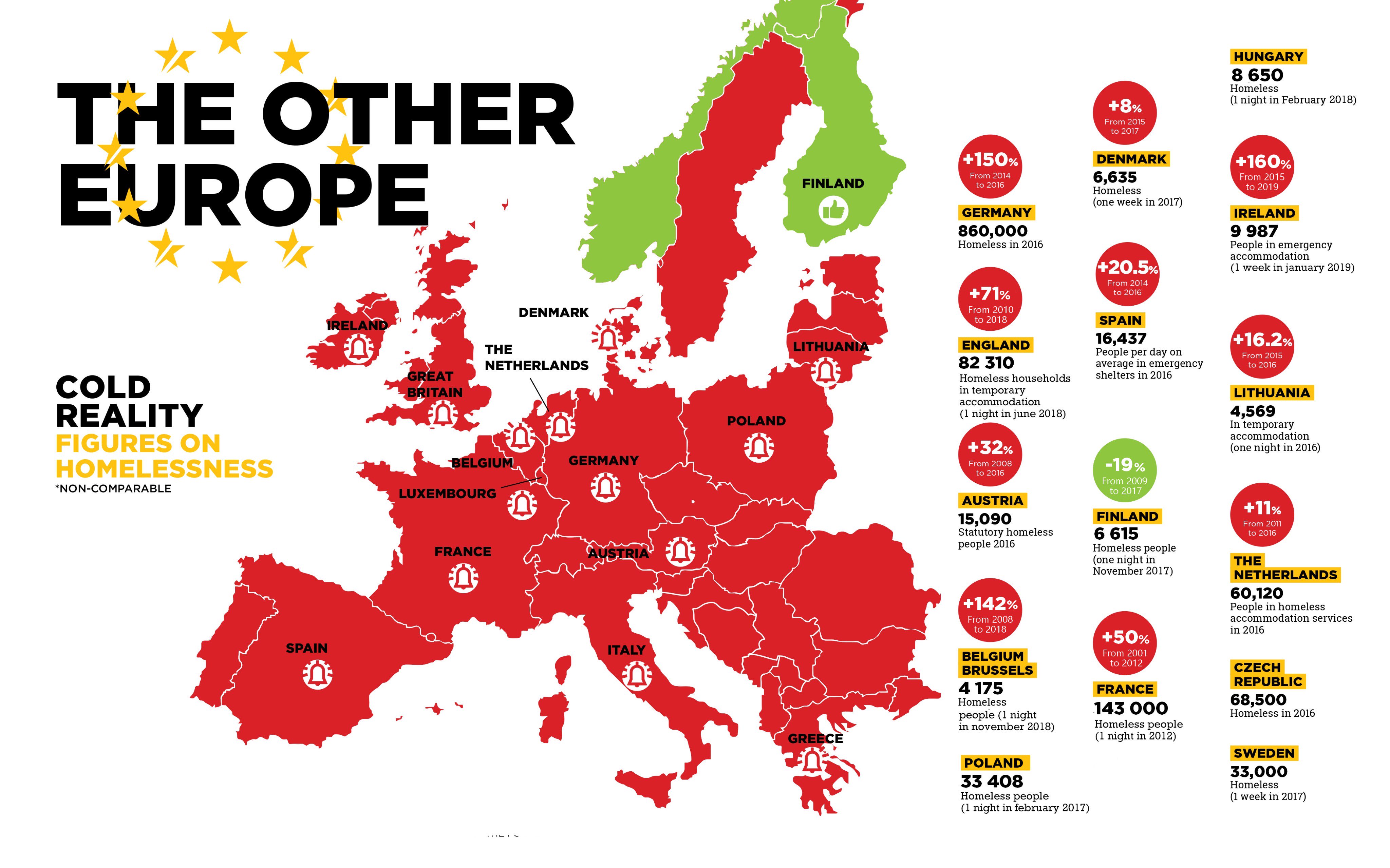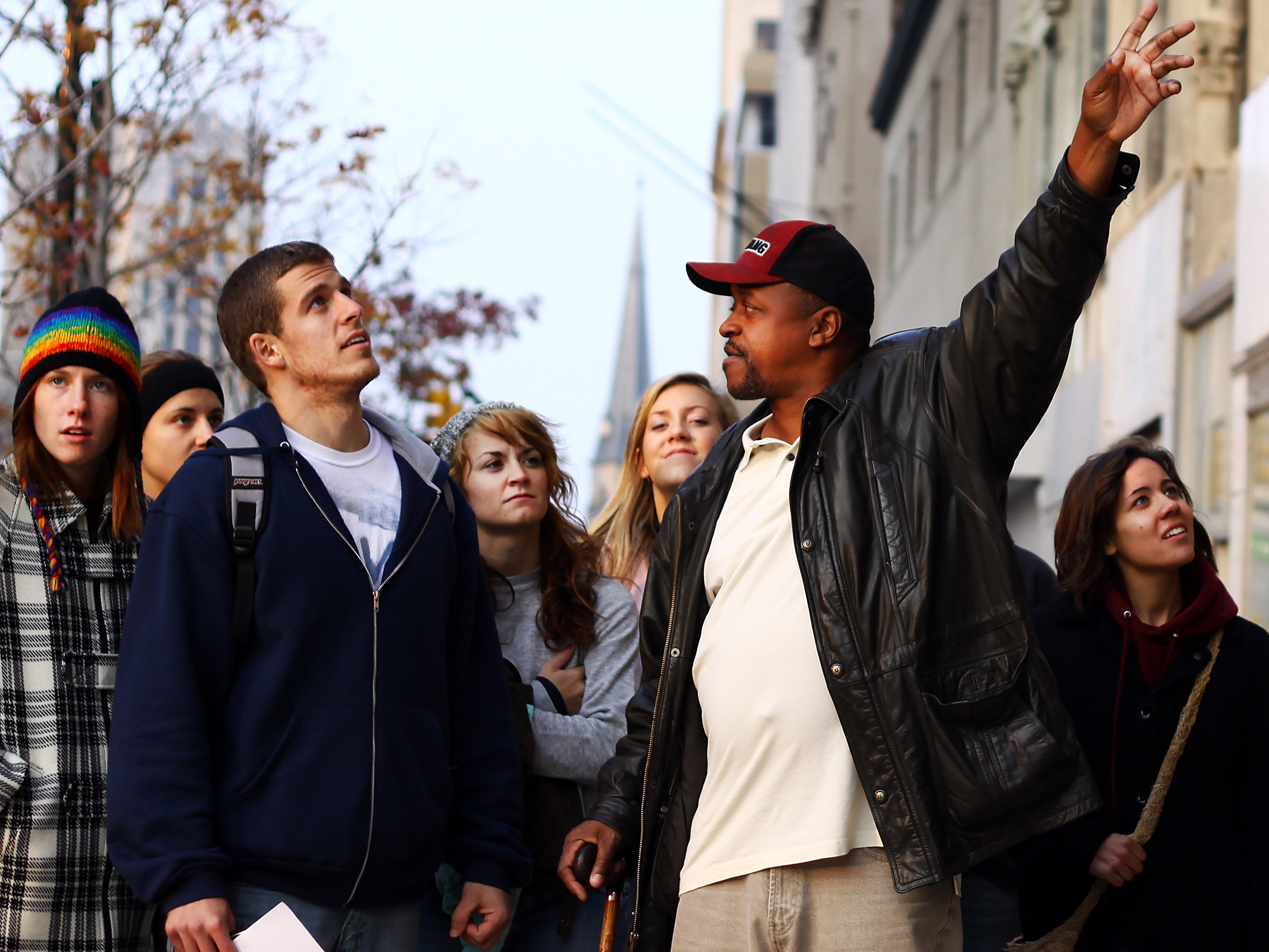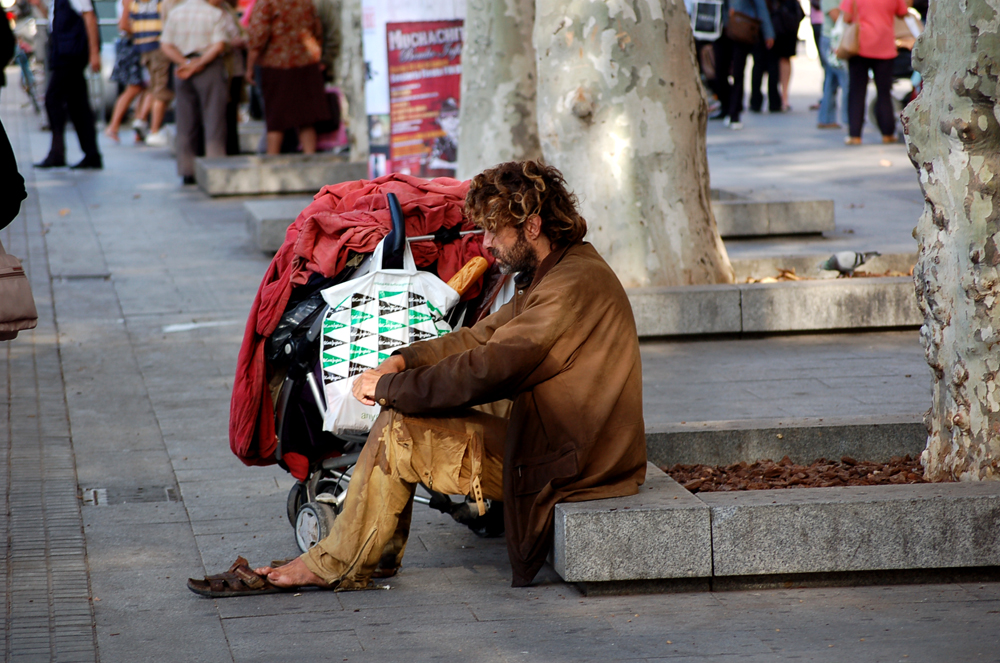22-12-2019
The new guides of European cities: the touristic narrative of homeless people
Marta Salvador | Alba SudTourism is present in very different contexts around the world and, being towed by the post fordism dynamics and the turning of poverty into a tourist attraction, it even reaches the homeless people. At the same time, the ethic questioning of these tourist offers is intensifying.

Photography by: Photoheuristic.info, creative commons licence.
The homelessness phenomenon is very present all around the world and, for this reason, it has been declared as a social emergency that needs to be faced. In Europe, homeless people usually concentrate on big cities which, at the same time, are touristified spaces. From the relation between both phenomena guided visits, led by homeless people who explain their experiences, emerge. However, these new touristic dynamics generate ethical debates about which narrative is created around poverty and the social exclusion of homeless people in a touristic context. Although the majority of local governments work to eradicate homelessness and support these new initiatives, in the case of Barcelona City Council, there have been opinions against the commodification of poverty, that has been done by Turisme de Barcelona. That is why, in addition to knowing what the real benefits are for the guides, a thought about the tourists’ gaze on this issue before making the visit and how their perception may change through this experience needs to be done.
The European phenomenon
During the last years, the number of people who face problems to obtain a source of livelihood and a place to spend the night has notably increased around the world. In the case of Europe, it has been detected as a social emergency because this phenomenon has grown in all the European Union member countries except Finland, thanks to their Housing Policies. According to the European Union (2019), the definition of homelessness includes those people who are in a situation of temporary, insecure or bad quality housing. The most common causes are: unemployment and poverty; migration; aging; health problems; breaking up with sentimental partners; lack of accessible housing to rent or buy; and appropriate support for people who abandon care centres, hospitals, prisons or other public institutions.
Although it is not possible to estimate the actual number of homeless people due to a lack of data and the use of very different methods to collect them, there are significant figures that FEANTSA, the European Federation of National Organisations Working with the Homeless, reveals. The most alarming data, as the following image shows, is from the United Kingdom, where the number of homeless people grew a 169% from 2010 to 2017, followed by Germany with 150% more from 2014 to 2016 and, thirdly, by Ireland where the phenomenon has grown 145% from 2014 to 2017. Countries such as Belgium with a 96% increase from 2008 to 2016, Austria with 32% more in the same years and Spain with 20.5% more people living in the 2014 to 2016 street, need to be highlighted too.

Map of Europe with homelessness data. Source: FEANTSA, creative commons licence.
Recent negative trends in the number of homeless people are due to changes in the housing market, mainly due to a sharp rise in rent and property prices, and also due to the precariousness of the labour market. Although more innovative solutions have been proposed, such as the integrated strategies and approaches of Housing First (prioritizing housing as opposed to the progressive service delivery scale model), there is little evidence today to accurately assess its effectiveness.
The homeless may face reduced life expectancy, health problems, discrimination, isolation and barriers to access to basic services and public benefits. In addition, they have great difficulty integrating into society in a way that is satisfying or that makes their life easier on the street. One possible answer to these challenges is a new concept that has emerged in some European cities and has created employment: homeless people, or those who have been living on the streets, becoming tourist guides. The type of work they do is guided tours on the towns’ streets run by homeless support organizations or private companies. This way, as tour guides, they can share their stories with visitors and make them discover new ways to see the city. Generally, these tourist routes do not focus on the usual and most popular places, but rather provide perspectives on the lives and previous experiences of homeless people (Hall, 2019).
This phenomenon, that is not older than 10 years, has been expanding in a large number of European cities and has been supported by many public authorities who hope to reduce the number of people sleeping on the street by promoting their working lives. On the other hand, many social enterprises have emerged, expressing that their main purpose is to change society's view of the homeless, such as the My Streets initiative in Dublin or Drogheda (Ireland). This company has a 3 months training program to teach new guides in a process of identifying visitors’ interests; creative writing about the route and getting experience with professional guides. Thus, different touristic itineraries are created, as each of them offers a unique perspective of the city (The observer, 2019).
In Dublin there is another company, Secret Street Tours, but as it was mentioned at the beginning, this practice is extended to other European cities, such as: Unseen Tours in London; Invisible Cities with guided tours to other Britain and Scottish cities; Querstadtein in Berlin; Amsterdam Underground in the capital of Netherlands; Pragulic in Prague; Shades Tours in Vienna; Visit Copenhagen in the capital of Denmark; L’alternative Urbaine in Paris; Surprise a Zurich; Shedia Invisible Tours in Athens; Nevid(e)na Lublana in Ljubljana or Invisible Zagreb in the capital of Croatia, among others. In addition to guided tours, some companies, such as Prague, offer experiences that include living a whole day as a homeless person. In this particular case, the day begins with a change of clothes and no personal items so that the participants pretend to be homeless. Then, along with the guide, their goal for the day is to survive, raising some money for food and water, and finding a place to spend the night. The company claims that with this activity it seeks participants to become agents of change through their own experience and, thus, to lose the prejudices that they had regarding homelessness and to take an interest in ending this situation. On the other hand, focus on this phenomenon has also been reflected in actions such as the creation of the Museum of Homelessness in London in 2015.

Guide and tourists doing a visit. Source: Jeffrey Smith, creative commons licence.
The case of Barcelona
The phenomenon of homelessness is also very present in the city of Barcelona. According to Fundació Arrels (2019), in Barcelona the number of homeless people has increased by 83% in the last 11 years. More specifically, 1,195 people are living on the streets according to the last count made by this foundation in May 2019, which means that there is a total of 3,864 homeless people in Barcelona, including those living in settlements or hostels, public and private centres and houses. Another alarming fact that the organization denounces is that 17.9% of the homeless are young people between the ages of 18 and 30, which can have consequences during the process of maturity and construction of their own life project. In addition, it highlights that some of these young people are women, who have become more invisible within the phenomenon of homelessness despite the great vulnerability to violence and harassment.
One of the policies implemented by the City Council of Barcelona, in order to give an answer to this problem, is the Plan for fighting homelessness 2016-2020, with nine main axes focused on addressing this emergency situation. On the other hand, Fundació Arrels and other non-profit organizations work day by day to improve the situation of these people. One of the actions that launched this foundation was the creation of guided routes by people who have slept on the streets of Barcelona. In this campaign, launched in October 2013, Fundació Arrels collaborated with Lisa Grace, founder of Hidden City Tours and pioneer in this project, to provide employment for the homeless.
This project is presented as a tourist alternative to get into an unknown Barcelona, seen through the eyes of someone who has lived on the street. As it appears on its web page, the Barcelona Streetlife Walking Tour and the Barcelona Classic Walking Tour are two routes that take about an hour and a half or two hours approximately, and are offered in Catalan, Spanish, English, German and French. In addition, as Carlos Garcia explains, the Hidden City Tours project was presented at the 7th International Conference on Responsible Tourism in Destinations, which was held in Barcelona in early October 2013.
After being operating for four years and establishing itself as a leisure offer for visitors and locals, Turisme de Barcelona included this activity in its promotion for commercial uses. As it states in its newsletter of June 2017, it is the first institution to implement this initiative that promotes social and labour reintegration and links the history of the city to its social reality. In this way, it welcomes the recommendations of the Third Sector commitment that aims to improve the welfare of people, especially those who are in a situation of social exclusion, promoting social cohesion and distribution of more equitable wealth.
However, the person formerly responsible of the Barcelona city council for the plan against the phenomenon of the homeless, Albert Sales, criticized the initiative via Twitter, as it is explained by Catalunya Diari (2017). Among his arguments he stated that he did not believe the proposal was really an initiative for reintegration if there was no stable income or affordable housing. He also added that the homeless are not a tourist attraction and, therefore, the folklorization of poverty does not help to break stereotypes or show that, if there are people on the street, it is because of a lack of access to housing. In addition, Laia Ortiz, former Deputy Mayor for Social Rights, asked Turisme de Barcelona for explanations about the commercialization of this initiative, saying that the City Council had not been consulted, despite the existence of a plan to fight homelessness, which addresses the prevention, reintegration and accompaniment of vulnerable people. The former Tourism Secretary, Agustí Colom, also said he did not know of the proposal. Despite this problem, Hidden City Tours guided tours are still being announced on the Turisme de Barcelona website.
On the other hand, this summer and through its website, Fundació Arrels has promoted routes around the city with special guides: people who have lived on the streets for a while. Through an hour and a half walks, it intends to teach a reality that is often hidden, to break prejudices and to sensitize locals and foreigners. As it states: “The aim is to take a stroll different from the usual tourist routes while discovering life stories and initiatives that work to make #noonesleepingonthestreet of the city'' (Fundació Arrels, 2019).

Source: Melvin Gaal, creative commons licence.
A new way of slum tourism?
The phenomenon of homelessness is already part of the touristic dynamics of many areas of the Global South where a new type of tourism, called slum tourism, has grown. In the early 1990's, sightseeing began to be organized in the most disadvantaged parts of countries such as India, South Africa, Brazil, etc. In recent years, the popularity of this phenomenon has been growing, and at the same time, there has been a proliferation of companies that are exclusively dedicated to promoting and commercializing these types of tours. The motivations of the tourists to carry out these routes are very diverse, among them it stands out helping and supporting the slums; see or do something different; experiencing the non-tourist part of a city; learn about the dynamics and living conditions of communities; as well as learning how they can improve, etc. (Araújo and Vieira, 2017).
Among the discussions generated by slum tourism are the motivations of tourists, companies and even the guides themselves who live in these neighbourhoods. The effects of this type of tourism on the communities and tourists who visit them are also analysed. In addition, there is often a romanticization of poverty, which usually comes from stereotypes previously created in the countries of origin of visitors, mostly located in the Global North, which can lead to contradictions within a phenomenon as complex as tourism.
All these discussions can be shifted to this new trend of "tour guides who have suffered homelessness". In this way, it would be necessary to think about the motivations of tourists, the thoughts or emotions caused by this type of guided routes, and even how the look of poverty is reproduced in a dynamic that occurs in the Global North. On the other hand, as some media call into question, it is interesting to know the real motivations of companies and the ultimate benefits of guides, both economic and social, and to analyse the real impact on the empowerment of these people. In addition, it can also be debated how the urban context relates to homelessness and, at the same time, how these guided tours convey the tale of private space and privacy within public space.
In conclusion, tourist phenomena such as those described should not make us lose sight of the fact that what really matters is the improvement of the living conditions of the homeless. Although the incorporation of these testimonies helps to reveal the darker side of cities, and therefore more real, it should be borne in mind that this activity can be a wicked and morbid dynamic, which results from increasing conversion of poverty into a tourist attraction. Finally, it is also necessary to address the ethical interpellation of this new dynamic for the stakeholders involved.
